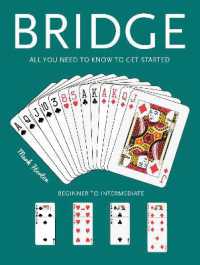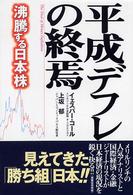Full Description
A robust revision, including many entirely new chapters addressing policy, the latest treatment approaches, and special topics, the Sixth Edition of The American Psychiatric Association Publishing Textbook of Substance Use Disorder Treatment offers a comprehensive and compelling review of this ever-evolving field. New sections address important topics that have gained prominence or become the focus of increased research attention since the Fifth Edition was released. For example, substance use and other psychiatric disorders often co-occur, and the resulting dual disorder is frequently associated with greater symptom severity and worse long-term prognosis than either disorder alone. Accordingly, the section on psychiatric comorbidity covers the epidemiology, assessment, and treatment of substance use disorders (SUDs) that co-occur with psychotic, mood, anxiety, eating, attention-deficit/hyperactivity, or trauma-related disorders. The section devoted to special populations has been revamped, and the topics have been thoroughly updated, some now covered by new contributors and others completely new to this edition. SUDs among women (including perinatal issues), adolescents, patients with chronic pain, sexual and gender minority populations, and older adults are addressed in detailed chapters, as are behavioral addictive disorders and cross-cultural aspects of substance-related and addictive disorders. Finally, the editors have included a section devoted to critically important topics in public health, including the U.S. opioid epidemic, cannabis policy and use, HIV/AIDS and hepatitis C, nicotine and public health, and the prevention of SUDs.
New or noteworthy coverage includes the following: • A chapter devoted to the legal and practical aspects of addiction in the occupational sphere, designed for clinicians who treat people with SUDs and/or develop workplace testing programs, employee assistance programs, and occupational drug/alcohol policies for these workers.• A chapter that surveys the growing literature supporting the use of mindfulness, exercise, and other "mind and body" practices (e.g., yoga, acupuncture, tai chi) as complements or alternatives to standard SUD treatment models.• A chapter devoted to hallucinogens, which clarifies their actions, psychoactive effects, historical uses, potential therapeutic benefits, and neural mechanisms, and both identifies their risks and seeks to dispel some of the misconceptions that have continued to surround them.• A suite of chapters devoted to cannabis, encompassing a review of its neurobiology and history, a survey of effective treatment approaches and harm-reduction strategies for cannabis use disorder, and a consideration of evolving public policy around cannabis use.• A trio of chapters devoted to nicotine and tobacco, encompassing a review of neurobiology, a survey of clinical assessment tools, a summary of the research base for effective treatments for tobacco use disorder, and a consideration of public health policy and interventions regarding tobacco use.
Evidence-based, down to earth, and meticulously edited, the new Sixth Edition of The American Psychiatric Association Publishing Textbook of Substance Use Disorder Treatment is an essential resource for clinicians who treat SUDs in a variety of settings -- from examining rooms to emergency departments, and from hospitals to recovery facilities.
Contents
Part 1: The Basis of Addictive Disorders
Chapter 1: Neurobiology of Addictions: Overview
Chapter 2: Genetics and Epigenetics in Addictions
Chapter 3: Epidemiology
Chapter 4: Diagnostic issues -- DSM-V, etc.
Part 2: Assessment and Treatment
Chapter 5: Assessment
Chapter 6: Screening and Brief Intervention
Chapter 7: Disease Model and Recovery
Part 3: Specific Drug Abuse: Neurobiology and Pharmacotherapy
Chapter 8: Neurobiology Alcohol
Chapter 9: Clinical Management of AUDs
Chapter 10: Neurobiology of Stimulants
Chapter 11: Clinical Management of Stimulants
Chapter 12: Neurobiology Opioids
Chapter 13: Buprenorphine and Methadone Maintenance
Chapter 14: Opioid Antagonists for the Treatment of Opioid Use Disorders
Chapter 15: Hallucinogens and Club Drugs
Chapter 16: Marijuana: Neurobiology
Chapter 17: Clinical management marijuana
Chapter 18: Neurobiology: Nicotine and Tobacco
Chapter 19: Clinical management tobacco
Chapter 20: Benzodiazepines and Other Sedatives and Hypnotics
Chapter 21: Treatment of Anabolic-Androgenic Steroid-Related Disorders
Part 4: Treatment Modalities
Chapter 22: Psychodynamics
Chapter 23: Cognitive-Behavioral Therapies
Chapter 24: Contingency Management
Chapter 25: Motivational Enhancement
Chapter 26: AA and Twelve-Step Facilitation
Chapter 27: Family Therapy -- Peter Steinglass
Chapter 28: Network Therapy -- Mark Galanter
Chapter 29: Technology-enhanced approaches
Chapter 30: Mindfulness, Exercise and other Alternative Approaches
Part 5: Public Health Issues
Chapter 31: Opioid Epidemic
Chapter 32: Marijuana Policy and Use
Chapter 33: HIV/AIDS and Hepatitis
Chapter 34: Public Health and Nicotine
Chapter 35: Prevention
Part 6: Special Populations
Chapter 36: Women and Addiction including perinatal issues
Chapter 37: Adolescent SUD
Chapter 38: Pain and Addiction
Chapter 39: LGBT Issues in Addictions
Chapter 40: Cross-Cultural
Chapter 41: Older Adults
Chapter 42: Behavioral Addictions
Part 7: Psychiatric Comorbidity
Chapter 43: Overview -- Epidemiology
Chapter 44: Affective Disorders
Chapter 45: Anxiety Disorders
Chapter 46: Eating Disorders
Chapter 47: ADHD
Chapter 48: PTSD
Chapter 49: Schizophrenia and Psychotic Disorders
Part 8: Special Topics
Chapter 50: Testing
Chapter 51: Forensics
Chapter 52: Medical Education
Chapter 53: Workplace Issues








